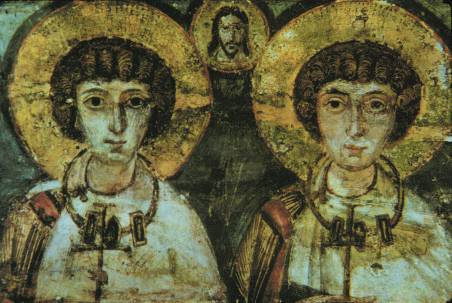As churches struggle with the issue of homosexuality, a long tradition of same sex marriage indicates that the Christian attitude toward same sex unions may not always have been as "straight" as is now suggested. A Kiev art museum contains a curious icon from St. Catherine's monastery on Mt. Sinai. It shows two robed Christian saints. Between them is a traditional Roman pronubus (best man) overseeing what in a standard Roman icon would be the wedding of a husband and wife. In the icon, Christ is the pronubus. Only one thing is unusual. The husband and wife are in fact two men.
<center>
 </center><center>St. Serge and St. Bacchus</center>
</center><center>St. Serge and St. Bacchus</center>
<center>[h=2]Is the icon suggesting that a
homosexual or same sex marriage
is one sanctified by Christ?[/h]</center> The very idea seems initially shocking. The full answer comes from other sources about the two men featured, <a href="http://www.cs.cmu.edu/afs/cs/usr/scotts/ftp/wpaf2mc/serge.html" _blank"="" target="_blank">St. Serge and St. Bacchus, two Roman soldiers who became Christian martyrs.While the pairing of saints, particularly in the early church, was not unusual, the association of these two men was regarded as particularly close. Severus of Antioch in the sixth century explained that "we should not separate in speech [Serge and Bacchus] who were joined in life." More bluntly, in the definitive 10th century Greek account of their lives, St. Serge is openly described as the "sweet companion and lover" of St. Bacchus.
In other words, it confirms what the earlier icon implies, that they were a homosexual couple who enjoyed a celebrated gay marriage. Their orientation and relationship was openly accepted by early Christian writers. Furthermore, in an image that to some modern Christian eyes might border on blasphemy, the icon has Christ himself as their pronubus, their best man overseeing their gay marriage.
<center>

<center>[h=2]Is the icon suggesting that a
homosexual or same sex marriage
is one sanctified by Christ?[/h]</center> The very idea seems initially shocking. The full answer comes from other sources about the two men featured, <a href="http://www.cs.cmu.edu/afs/cs/usr/scotts/ftp/wpaf2mc/serge.html" _blank"="" target="_blank">St. Serge and St. Bacchus, two Roman soldiers who became Christian martyrs.While the pairing of saints, particularly in the early church, was not unusual, the association of these two men was regarded as particularly close. Severus of Antioch in the sixth century explained that "we should not separate in speech [Serge and Bacchus] who were joined in life." More bluntly, in the definitive 10th century Greek account of their lives, St. Serge is openly described as the "sweet companion and lover" of St. Bacchus.
In other words, it confirms what the earlier icon implies, that they were a homosexual couple who enjoyed a celebrated gay marriage. Their orientation and relationship was openly accepted by early Christian writers. Furthermore, in an image that to some modern Christian eyes might border on blasphemy, the icon has Christ himself as their pronubus, their best man overseeing their gay marriage.
